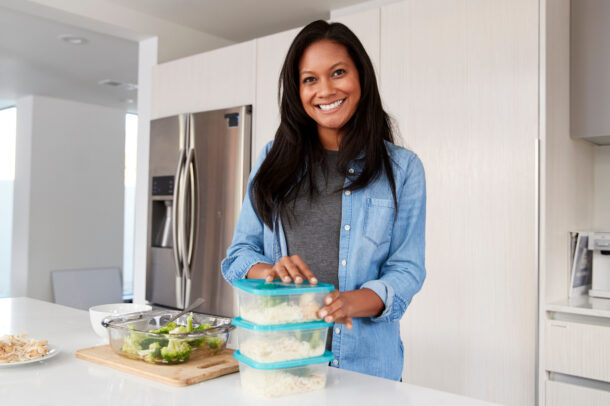By Camille Lyu, Nutrition Student and Dani Renouf, RD, MSc, CDE
With skyrocketing food prices, managing a kidney-friendly diet and staying within the budget can be challenging. The good news is that enjoying a nutritious and balanced diet doesn’t have to be expensive. This blog post will offer tangible tips and tricks to lower food costs and avoid food waste.
- Buy in bulk and batch cook
You can easily control the amount you buy in bulk to avoid food waste. Staples like grains, pasta, beans, and legumes are often cheaper when you purchase them in bulk. Bulk sections are easily accessible at most grocery stores. You can also visit bulk specialized stores for a bulk treasure hunt!
Taking 1-2 hours weekly to batch-cook your grains and legumes and pop them into the freezer can be a huge time saver for the coming week. A low-sodium diet supports kidney health, and many processed products have added salt. Batch-cooking your own ingredients and meals can lower your sodium intake over time. Having these staples ready to mix and match also makes preparing a healthy homemade meal more convenient on busy weeknights.
- Enjoy frozen fruits and vegetables
It is a common misconception that frozen fruits and vegetables are less nutritious than fresh ones. In fact, at a fraction of the cost, frozen fruits and vegetables are excellent and convenient sources of micronutrients and dietary fiber to add to your diet. Fruits and vegetables are picked at peak seasons to be processed and frozen. This means that the nutrients are retained and preserved at their peak.
Increasing fruit and vegetable intake may support body weight management and decrease blood pressure which in turn helps support kidney health.
- Meal plan and purchase accordingly
Of food produced for consumers in Canada, 58% is wasted. One strategy that can help reduce food waste is meal planning and only buying what you need. If you are someone who doesn’t like eating the same thing over the week, plan and prepare a component or two for each food group instead of a specific recipe.
Aim for 1-2 grains or starchy vegetables, 1-2 proteins, and some roasted or precut vegetables. This way, you can enjoy the flexibility of creating different meals while reaping convenience benefits with meal prepping.
When heading to the grocery store, make a shopping list and only buy what you need. Have a meal or snack beforehand so you are not super hungry. This way, you are much less likely to purchase anything at sight and end up with more groceries than you need.
- Enjoy more plant-based proteins and less meat
Plant-based proteins like tofu, tempeh, beans, nuts, and seeds often come at a lower price than meat. They also come with the added benefits of less saturated fat, more dietary fiber, and more phytonutrients. A study*a has shown that a diet with more plants can positively support kidney health. See this blog for more information on why our kidneys love more plants.
Note: Beans and legumes can be high in potassium and phosphorus. Soaking dry beans and legumes before cooking can reduce their potassium and phosphorus contents. Before adding beans and legumes to your diet, please consult your healthcare providers about your specific conditions.
References:
*Goraya, N., Munoz-Maldonado, Y., Simoni, J., & Wesson, D. E. (2021). Treatment of chronic kidney disease-related metabolic acidosis with fruits and vegetables compared to nahco3 yields more and better overall health outcomes and at comparable five-year cost. Journal of Renal Nutrition, 31(3), 239–247. https://doi.org/10.1053/j.jrn.2020.08.001
